24 Jan 2011
by ARTbyVENY
in Fine Art
Tags: 16” x 20”, Acrylic Paintings, Brick House, canvas size, flowers, linen canvas, Rose Bushes, roses
Brick houses are beautiful; add flowers and they become even more eye inspiring. When looking for a new house you immediately picture a perfect house in your mind. It is different story when you actually start seeing houses :). One has this, but lack of this or vice versa.
Anyway we are on the market for a house and maybe this provoked me to look at my “to do” project pool and choose to paint this acrylic painting on canvas “Brick House with Rose Bushes”. I love roses; they look majestic on a brick wall and aroma when they bloom is mmm…yummy :). Can you feel it?
I went for 16” x 20” (40cm x 50cm) linen canvas which I thing is perfect canvas size, not too small and not too big.
Have I succeeded?
What do you think about “Brick House with Rose Bushes”?
Click on the picture bellow to learn more details about the story of this painting and its prototype.
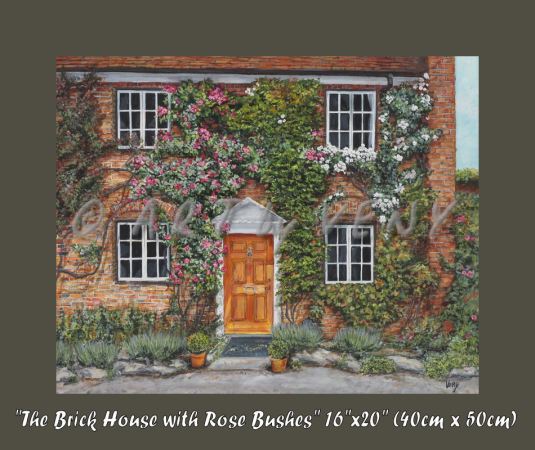
The Brick House with Rose Bushes Cityscape Art_Original Art by Veny
All contents © copyright 2010 ARTbyVENY.com
I invest substantial amount of time to find and research interesting and relevant topics for my blog page.
If you like to support my research efforts donate now to keep this blog site alive.

Thank you! Your donation is appreciated!
23 Jan 2011
by ARTbyVENY
in Art News
Tags: Art news, Chihuly, Dali, Degas, Fine Art, Florida, French Impressionist, glimpse, Kinetic Sculptures and Drawing, Lloyd Webber, London, Monet, Paris, retrospective, Rockwell's Americana art, Tampa Bay
Art lovers queue through night for glimpse of Monet
PARIS – Thousands of art lovers queued in freezing temperatures on Saturday night for a final glimpse of a major retrospective on French Impressionist Claude …
Sun Jan 23, 2011
Chihuly Collection, Dali Museum draw art lovers to Florida
By Tamara Lush associated Press travel – Dali, Chihuly and Degas? It’s possible to see all three in one weekend in the Tampa Bay area — and still have time for …
Sun January 23, 2011
Asians toast Lloyd Webber’s wines in $5.6 million sale
… of the biggest and most commercially successful musicals in recent decades such as “The Phantom of the Opera” and “Cats” is also well-known as an art and wine …
Sat Jan 22, 2011
Blankfein Portrait, Freud, Bacon Works Ignite Online VIP Art Fair
… Freud, Bacon While the number of works with price tags of more than $1 million shrunk at art fairs since …
Sat Jan 22, 2011
Exhibitions: Rockwell’s Americana art on show in London
By Olesya Dmitracova. LONDON, Jan 21 – Works by illustrator Norman Rockwell famous for his images of idealized small-town America …
Fri Jan 21, 2011
Cycles of an artistic nature ‘Kinetic Sculptures and Drawings’ kicks off 2011 museum’s Regional Artists’ Exhibitions
BENNINGTON – Artist Joe Chirchirillo, in his artist’s statement, says his works are “sculpture systems, pieces that draw their inspiration from …
Th Jan, 20, 2011
20 Jan 2011
by ARTbyVENY
in Fine Art
Tags: abstract artists, Contemporary Art Works, contemporary artists, Famed Boston Artist Veny, famous artist, Online Gallery, paintings, Signed artworks
ADI-News.com released an article, Signed, Contemporary Art Works by Famed Boston Artist Veny are Being Presented at Online Gallery, about me, my work and my online gallery. The article says some very flattering things about my work and even quoted me from the website. I may be too modest, but being referred to as a famous artist is both a little embarrassing, but also very nice at the same time. Three of my favorite works were displayed in the article so that is nice to have my work get more viewers.
Veny’s work can match the best works of abstract artists as well as completely realistic depictions of life. Her talent and training has made her one of the most sought after contemporary artists in Boston and the world. Veny is even taking commissioned painting requests and has decided to limit herself to only a few of these requests. This limitation has created more value for the prize of a commissioned work by Veny and the online gallery has received several requests for the honor. ADI-News.com.
Even this very blog was mentioned in the article. It’s very nice to be recognized in such a way and to have my artwork seen by a broader audience. I really like that my friends and family were mentioned in the article. They mean so much to me and it’s good to have them recognized because they are really my biggest inspiration in my creative process. One thing in the article that was intriguing was how many artists paint some of their greatest works out of dark times.
As with the great artists, much of their talent and beautiful artwork came from a much darker time or place. It is as if art is fueled by tragedy and loneliness and can creating something of beauty is an escape for the artist. Veny’s works are much the same and her story as an artist began in a similar manner…ADI-News.com.
I think that this is a true statement. There are a lot of beautiful paintings that have come from sadness or tragedy just so that the artists can escape to a happier place, a place where their thoughts are so focused on creation and not the sadness or tragedy itself. That is why I think that art is very therapeutic for many and if more conflicts in the world could be resolved by creation rather than destruction, it would be a more beautiful world.
I really like that the Boston art community was mentioned. Boston is such a great city and I like that I am able to bring it some recognition in a positive way. Boston has done so much for me and I like giving back. Well, I thought I would mention the news article and maybe see what some of you thought about it. I like that the article can be shared on Facebook and Twitter. If you liked the article feel free to share it with your friends!
All contents © copyright 2010 ARTbyVENY.com
20 Jan 2011
by ARTbyVENY
in Art History, Fine Art
Tags: Bestiaire et Musique, cathedrals of Reims and Metz, Chagall, Chicago, Cogniat, colorful vegetation, Egypt, European modernism, France, Holland, Italy, Jerusalem Windows, Jewish identity, Jewish rites, Jews, Joseph Goebbels, kaddish, landscapes, Marc Shagall, Matisse, Mediterranean, museums, Nazi occupation, Nice, Painter, Palestine, Paris Opera, passion for color, Picasso, Pierre Matisse, Reinhardt gallery of New York, Russia, Russian revolution, Spain, United Nations, United States, Vallauris, Venice, Western civilization, Word War I, World War II
….continued
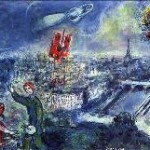
By 1926 Chagall had his first ever exhibition in the United States. Over 100 works were shown at the Reinhardt gallery of New York, although he did not travel to the opening. Ironically it was not until 1927 that Chagall made his name in the French art world.
During this period in France he traveled throughout the country and fell in love with Cote d’Azur, where he was impressed by the rich greenness of landscapes, colorful vegetation, the Mediterranean blue and the mild weather. His wife Bella had always a special role in his life. According to Chagall she was the living connection to Russia that allowed him to evolve as an artist in exile. He also visited nearby Holland, Spain, Italy, Egypt and Palestine and later wrote on paper the impressions some of those travels left on him: in Holland it was the throbbing light, like the light between the late afternoon and dusk. In Italy he found that peace of the museums which the sunlight brought to life. In Spain he found inspiration of a mystical, if sometimes cruel, past. And in the Palestine he found unexpectedly the Bible and a part of his very being.

Beginning in 1937 more than twenty thousand works from German museums were confiscated as “degenerate” by an order from information and propaganda committee headed by Joseph Goebbels. Although the German press had once admired his art, the new German leadership now made a mockery of Chagall’s art, describing them as “green, purple, and red Jews shooting out of the earth”…and therefore representing assault on Western civilization.
World War II was on the horizon…
After Germany invaded and occupied France, Chagall naively remained in, unaware of the intentions of Vichy Government to let the Nazis to collect French Jews and sent them to German concentration camps, from which nearly all would never return. Chagall’s attachment to France blinded him and didn’t allow him to judge the situation realistically.
After numerous warnings by their daughter Ida, who desperately stressed the need to act fast, Chagalls agreed to leave France. But it was the help from Alfred Barr who actually saved Chagall by adding his name to the list of prominent artists, whose lives were at risk, that the United States should try to extricate. He left France in May 1941 – almost too late. Other artists like Picasso and Matisse were invited to come to America too but they decided to remain in France. Chagall and Bella arrived in New York on June 23, 1941, which was the next day after Germany invaded Russia.
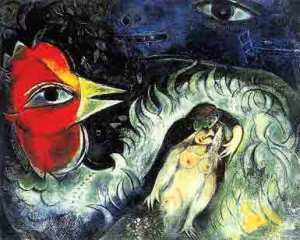
Although he was recognized in America, well before his arrival, Chagall did not feel comfortable. He felt not practically suited for this new role in a foreign country whose language he could not yet speak. He became a public figure mostly against his will, feeling lost in the strange surroundings. In addition his discomfort in America was compounded by his knowing that why he left France under Nazi occupation the fate of millions of other Jews was at risk. It took a while before he began to settle down in New York which was full of writers, painters, and composers who, like himself, had fled from Europe during the Nazi invasions. He spent time visiting galleries and museums, and befriended other painters. But the contemporary American artists did not yet understand or even like Chagall’s art. For them ‘Parisian Surrealism,’ meant little to nothing. Things started to change when Pierre Matisse, the son of recognized French artist Henri Matisse, became his representative and held Chagall exhibitions in New York and Chicago in 1941. Critics slowly but surely liked his art. By 1946 his artwork was becoming more widely recognized and acclaimed.

After the liberation of France Chagall returned to Paris alone as his wife Bella has died in New York from infection. He traveled throughout Europe and chose to live in the Cote d’Azur which at that time had become an artistic centre. Henri Matisse lived above Nice and Picasso lived in Vallauris. Although the three famous artists lived nearby and sometimes worked together, there was artistic rivalry between them as their work was so distinctly different, and they never became long-term friends. Regardless Picasso had great respect for Chagall and the rumors are saying that once Picasso noted: “When Matisse dies, Chagall will be the only painter left who understands what color is… His canvases are really painted, not just tossed together. Some of the last things he’s done in Venice convince me that there’s never been anybody since Renoir who has the feeling for light that Chagall has.”
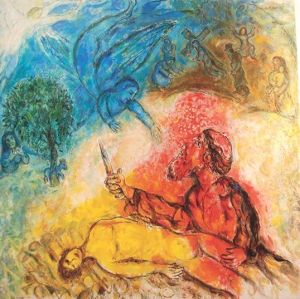
Critics who studied Chagall’ work are noticing like one that in all of his work, it was his colors which attracted and captured the viewer’s attention. The colors are a living, integral part of the picture and are never passively flat, or banal like an afterthought. His colors do not even attempt to imitate nature but rather to suggest movements, planes and rhythms. He was able to convey striking images using only two or three colors.
One of them, Cogniat writes, “Chagall is unrivalled in this ability to give a vivid impression of explosive movement with the simplest use of colors…” Throughout his life his colors created a “vibrant atmosphere” which was based on “his own personal vision.
Chagall’s paintings would later sell for record prices. In October 2010 his painting “Bestiaire et Musique,” depicting a bride and a fiddler floating in a night sky amid circus performers and animals, “was the star lot” at an auction in Hong Kong and it sold for $4.1 million, to become the most expensive contemporary Western painting ever sold in Asia.
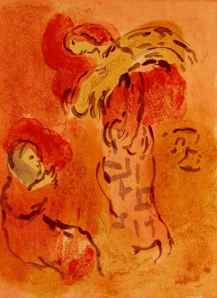
According to art historian Michael J. Lewis, Chagall was considered to be “the last survivor of the first generation of European modernists.” For decades he “had also been respected as the world’s preeminent Jewish artist.” Using the medium of stained glass, he produced windows for the cathedrals of Reims and Metz windows for the United Nations, and the Jerusalem Windows in Israel. At age 77 he also did large-scale paintings, including the ceiling for the Paris Opera.
Chagall, the last surviving master of European modernism, died in France in 1985. He had experienced at first hand the high hopes and crushing disappointments of the Russian revolution, Word War I, and had witnessed the end of the Pale, the near annihilation of European Jewry, and the obliteration of his home town of Vitebsk, where only 118 of a population of 240,000 survived the Second World War.
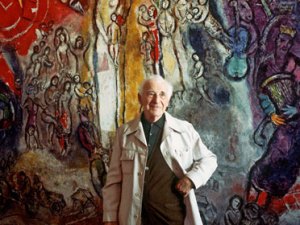
He came from nowhere to achieve worldwide acclaim. Yet his fractured relationship with his Jewish identity was unresolved and tragic. Ironically Chagall would have died with no Jewish rites, had not a Jewish stranger stepped forward and said the kaddish, the Jewish prayer for the dead, over his coffin.
All contents © copyright 2010 ARTbyVENY.com
I invest substantial amount of time to find and research interesting and relevant topics for my blog page.
If you like to support my research efforts donate now to keep this blog site alive.

Thank you! Your donation is appreciated!
20 Jan 2011
by ARTbyVENY
in Art History, Fine Art
Tags: Andre Dunoyer De Segonzac, art world, avant-garde artists, Bella Rosenfeld, Berlin, Bible, Марк Захарович Шагал, France, Gauguin, Germany, gouache., Hebrew, Henri Le Fauconnier, Jewish, Jewishness, Jews, Latin Quarter, Manet, Marc Chagall, Matisse, Moishe Shagal, Monet, Montmartre, Moscow, My Life, Nazi, October revolution, painters, Paris, Paul Gauguin, Picasso. Matisse, poets, Rembrandt, Renoir, Saint Petersburg, State Jewish Chamber Theater, Suprematist, Van Gogh, Vitebsk, World War I, Yury Pen
Chagall, another French artist, associated with several key art movements was one of the most successful artists of the past century. He created unique works in virtually every artistic medium, including painting, book illustrations, stained glass, stage sets, ceramic, tapestries and fine art prints. Chagall even earned great respect from Pablo Picasso. However his life was full of unexpected turns, rocks and his guardian angel was quite busy making sure he survive in this bumpy ride. 🙂
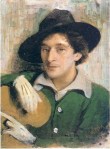
Marc Chagall (Russian: Марк Захарович Шагал), born as Moishe Shagal, in 1887 near the city of Vitebsk in today’s Belarus (then part of the Russian Empire). His father worked for herring merchant carrying heavy barrels all day long for only 20 rubles (55 francs) a month. His mom was selling groceries from their home.
During that time Jewish children were discriminated and not allowed to attend regular Russian schools or universities. Jewish were also restricted with movements within towns and cities. The only alternative was the local Jewish religious school where Chagall received his primary education studying Hebrew and the Bible.
He could probably become laborer like his father or sell groceries like his mother if his mom didn’t decide to put him through a Russian high school. The only problem was that they weren’t taking Jews. Chagall’s courageous mother then bribed the school headmaster and at age 13 Chagall was accepted. It is ironic that 50 rubles (137 francs) opened the road to success for Chagall. The starting point in his artistic life was the moment when he first noticed a fellow student drawing. Chagall would later say how there was no art of any kind in his family’s home and the concept was totally foreign to him, but attracted him as magnet.
Eventually Chagall confided to his mother, that he want to be a painter”, although she could not understand his sudden interest in art or why he would choose a vocation that seemed so impractical. She did not have any money to offer but gave him her moral support and approval. Soon Chagall was visiting the studio of local realist artist Yury Pen who also ran a small drawing school in Vitebsk. Chagall was accepted for free due to his financial hardship.However, after only a few months at the school, Chagall found that academic portrait painting is not suitable for his desires.

In 1906, he moved to the capital Saint Petersburg which then was the center of the country’s artistic life with its famous art schools. But Jews were not permitted into the city without an internal passport, so Chagall has managed to get a temporary passport from a friend. He enrolled in a prestigious art school and studied there for two years. By 1907 he had begun painting naturalistic self-portraits and landscapes. During this time he also discovered experimental theater and the work of such artists as Paul Gauguin. Chagall often visited Vitebsk where he met and fall in love with his future wife Bella Rosenfeld.
To avoid the discrimination in Russian society during this time Jews had only two basic ways to join the art world: either to hide or deny their Jewish roots by avoiding public expressions of Jewishness or as Chagall chose to cherish and publicly express his Jewish roots and incorporate them into his art.
In 1910 driven by his dream of Paris, the city of light and freedom, Chagall moved to France where he hoped to develop his own artistic style. His first days were not easy, 23-year-old Chagall found himself alone in the big city and unable to speak French. At this time Cubism was the dominant art form and French art was still dominated by the material outlook of the 19th century. Eventually Chagall’s gift for pure color and feeling for simple poetry combined with a fresh unashamed sense of humor surprisingly resulted in his first recognition not from other painters but from poets.
In Paris he enrolled at the art academy La Palette where he studied under Andre Dunoyer De Segonzac and Henri Le Fauconnier. He made a living by working in another academy. In his free time Chagall was visiting art places: salons and galleries including Louvre where he studied masters like Rembrandt, van Gogh, Gauguin, Renoir, Matisse, Manet, Monet and others. He was also regular at Montmartre and the Latin Quarter and learned the technique of gouache.
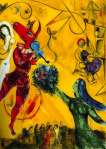
While Chagall was happy just to breed the air in Paris he missed Vitebsk and even more his fiancé Bella. Two years after he arrived in France he accepted an invitation from a reputable art dealer in Berlin and left Paris with some 40 paintings and over hundred gouaches. The exhibit in Germany was a huge success but Chagall was anxious to see Bella so he continued on to Vitebsk. He planned to stay only long enough to marry Bella, but just few weeks later something unexpected forced him to change his plans. The First World War broke out, closing the Russian border for an indefinite period. A year later Chagall married Bella Rosenfeld and later their first child Ida was born.
Then in 1917 the October revolution came and while it was dangerous time for Chagall it also offered him a unique opportunity. Who would think that once segregated a Jew artist will become one of the Soviet Union’s most distinguished artists and a member of the modernist avant-garde. Chagall enjoyed special privileges and prestige. He was even offered a prestigious position as a commissar of visual arts for the country but instead took a position as commissar of arts for Vitebsk. He then found the Vitebsk Arts College which later became the most distinguished school of art in the entire Soviet Union. Chagall’s idea was to attract one of the most important and independently minded artists in the country to teach at the school. Few months later Chagall left for Moscow after a clash with some key faculty members who preferred a Suprematist art of squares and circles and rejected Chagall’s attempts as creating “bourgeois individualism” in their teachings.
In Moscow he was offered a position as stage designer for the newly formed State Jewish Chamber Theater. For its opening he created a number of large background murals using techniques he learned from his early teacher. One of the key murals was 9 feet (2.7 m) tall by 24 feet (7.3 m) long and included images of various lively subjects such as dancers, fiddlers, acrobats, and farm animals. Critics love the mural and one critic at the time called it “Hebrew jazz in paint.” Some of Chagall’s later large-scale works included murals for the Paris Opera and New York Metropolitan Opera.
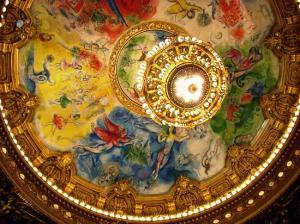
Moscow is where Chagall first began exhibiting his work at a well-known salon and later on in St. Petersburg. He again showed his art at a Moscow exhibition of avant-garde artists. This constant exposure caused his name to spread and a number of wealthy collectors began buying his art. He also began illustrating a number of Yiddish books with ink drawings. Chagall had turned thirty and had begun to make a name for himself.
The World War I ended in 1918 but the life quickly became a hardship for Russians as famine spread. Chagall moved to a smaller, less expensive, town near Moscow, despite the everyday crowded train commute to Moscow. Between 1921 and 1922 Chagall lived in primitive conditions and he decided to move back to France so that his art could grow in an atmosphere of greater freedom. Indeed the lack of freedom not the poor life conditions was the main driver behind his desire to go back to France. Chagall was not alone, numerous other artists, writers, and musicians were also planning to move to the West. Chagall applied for an exit visa and while waiting for its uncertain approval, wrote his autobiography “My Life”.

In 1923 Chagall finally was given permission by Soviets to leave Moscow and to return to France. On his way back he stopped in Berlin to recover the many paintings he had left there on exhibit ten years earlier, before the World War I began, only to find that everything was either destroyed or lost. With all his early works now lost, he began trying to paint from his memories of his earliest years in Vitebsk with sketches and oil paintings.
(To be continued)
All contents © copyright 2010 ARTbyVENY.com
I invest substantial amount of time to find and research interesting and relevant topics for my blog page.
If you like to support my research efforts donate now to keep this blog site alive.

Thank you! Your donation is appreciated!
15 Jan 2011
by ARTbyVENY
in Art History, Fine Art
Tags: Academy Suisse, art, Artist, Bazille, Claude Monet, color, Courbet, impression, Impressionism, Impressionist movement, impressionists, landscape paintings, light, Monet, old masters, paint, paintings, Paris, Pissarro, Renoir, Sisley, The Louvre
I have been always a big admirer of Claude Monet and his art, but what I really value the most is his courage and faith. Highly successful in his time Monet became an icon for Impressionist movement. But his road was rocky; he fought every step to earn his status.
I believe that there is always the right time and the right person for everything and Monet was the one to reject the traditional approach to landscape painting and instead of copying old masters he had been learning from his friends and the nature itself.
His father wanted him to go into the family grocery store business, but Claude Monet wanted to become an artist. When Monet traveled to Paris to visit The Louvre, he witnessed painters copying from the old masters. Monet, having brought his paints and other tools with him, would instead go and sit by a window and paint what he saw. Monet was in Paris for several years and met several painters who would become friends and fellow impressionists.
The term Impressionism is derived from the title of his painting Impression, Sunrise. He first became known locally for his charcoal caricatures with huge heads, which he would sell for ten to twenty francs. In his early days Monet whose income solely came from his paintings, had to conform somewhat to the Realist style even though he clearly disliked it. Despite his efforts to include Realist aspects in his paintings, Monet’s individuality was still evident. In the following years, it became increasingly clear that Monet was definitely more than a realist.
His friends were Renoir, Sisley, Courbet, Bazille and Pissarro. Together they shared new approaches to art, painting the effects of light en plein air with broken color and rapid brushstrokes, in what later came to be known as Impressionism.
Rejecting the rigidity of conventional training, Monet enrolled in the Academy Suisse, a studio without a set curriculum where students could set their own schedules and paint from life models as well as exchange ideas. Perhaps his love of painting inspired him to do portraits and still life. In addition to being easier to sell than landscapes, still life allowed the artist to continue his experimentation with the textures and colors of nature during periods when bad weather prohibited him from painting outdoors. Rejecting the rules of classical landscapes, the artist concentrates on reflecting changes in light and color, producing an astonishingly fresh momentary impression. He found delight in the reflections of water, sea breezes, the light of the sun, the pleasures of the countryside, and the value of the present moment.
With his own vision which is quite different from the world’s Monet occupies a special place in the art world. Artist who does not cared to falsify his feelings although it would be in his best advantage to play to widespread concepts. Every insult of his style made him and his friends stronger and he insist even more on continuing the chosen path.
If you love Monet’s art, like I do, then do not be discouraged and walk with me in the steps of Claude Monet to re awake his passion for light and art.
All contents © copyright 2010 ARTbyVENY.com
I invest substantial amount of time to find and research interesting and relevant topics for my blog page.
If you like to support my research efforts donate now to keep this blog site alive.

Thank you! Your donation is appreciated!
11 Jan 2011
by ARTbyVENY
in Fine Art
Tags: American architecture and design, art, art of design, Barbara to Barbra, Barbra, Barbra Streisand, Christmas, Christmas gifts, collecting, Columbia records, design, Elegant Barn, exquisite taste, influential figures, Little Barbara, Lou Kind, Manhattan to Malibu, Mill House, million dollar homes, My Passion for Design, nourish, screening room, sense of style, soul, used-car salesman
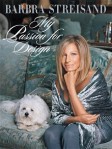 I saw the book in the local bookstore when one day my husband and I stopped for a cup of coffee. It was one week before Christmas. I was sold on it right away but the $60 price tag stopped me from buying it. Plus my husband and I agreed not to have Christmas gifts for ourselves and just for the kids.
I saw the book in the local bookstore when one day my husband and I stopped for a cup of coffee. It was one week before Christmas. I was sold on it right away but the $60 price tag stopped me from buying it. Plus my husband and I agreed not to have Christmas gifts for ourselves and just for the kids.
I must had the “wow” look on my face so obvious that my husband decided to surprise me. So I have received Barbra Streisand’s “My Passion for Design” book for Christmas. Can’t tell you how much this meant for me! Amazingly I also received a coffee mug I fall in love with while we have visited the same coffee shop. In the rush my husband did not see what was written inside in the mug: “The best Dad ever” 🙂
We had a good laugh…..and both ended up with Christmas gifts!
Back to the book…I went through it in a day or so and then back again to read different parts of it slowly….like eating a bar of my favorite chocolate.
For almost fifty years Barbra Streisand has been one of the singular and most influential figures (in my very own opinion) in American entertainment. Now, in her first book, Barbra Streisand undercover another aspect of her talent: the taste and style that have inspired her beautiful homes and collections. Her book focuses on the architecture and construction of her newest homes, the dream refuge that she has dreamed for since the days when she shared a small Brooklyn apartment with her mother, brother, and grandparents.
A culmination and reflection of Barbra Streisand’s love of eighteenth and twentieth century’s American architecture and design, “My Passion for Design” contains many of her very own photos of the rooms she has decorated, the furniture and art she has collected for many years, and the heavenly gardens she has planted on her land on the California coast. In addition to the rare and intimate private tour of her homes, Barbra shares memories of her childhood, the development of her sense of style, and what collecting has come to mean to her. When Streisand talks about the “Elegant Barn” and “Mill House” she designed, both featured in the book, the attention to every detail and getting things right was pretty intense.
It’s hard to say how one acquires an eye for art or design, but I don’t think I developed it at home, unless it was in rebellion from what I was seeing. I couldn’t afford to buy art, but I found old gilt frames and hung them on the walls, just framing space, says Barbara in her book.
I think that Barbra Streisand stands up among many other celebrities because she is down to the earth and never forgets she grew up with next to nothing. Little Barbara slept in a bed with her mother, and her brother had a roll-away cot in the same room. Barbara says: “We didn’t have a couch, I guess because we didn’t have a living room.”
A month ago I watched a rare, live interview with Barbra Streisand. Even though most mortals will not get the chance to design million dollar homes, and may not be blessed with the same “exquisite” taste, I can dream and reveal a bit in her devotion to details. She shared that part of her meticulous detail to design came from a less than fortunate childhood. Preference for colors is psychologically linked to childhood, she said. Streisand says she felt rebuffed by her mother and step-father, Lou Kind, a used-car salesman, and attributes many of her personality characteristics to those early experiences.
Thanks to her stage role popularity, Streisand was signed by Columbia records and recorded. The path from Barbara to Barbra, Manhattan to Malibu, has been neither linear, nor always successful. Music legend is a long way from where she started out in Brooklyn: today, she lives in a home with a screening room, its very own shopping street and interiors that nourish my soul.
Have you read “My Passion for Design” book yet? Let me know what you think, whether you agree or disagree with me. I love to hear your comments.
All contents © copyright 2010 ARTbyVENY.com
I invest substantial amount of time to find and research interesting and relevant topics for my blog page.
If you like to support my research efforts donate now to keep this blog site alive.

Thank you! Your donation is appreciated!
07 Jan 2011
by ARTbyVENY
in Fine Art
Tags: acrylic, acrylic on canvas, Acrylic Paintings, acrylic paintings on canvas, art, Buy Original Acrylic Art, canvas, cityscape, Cityscape Art, gondola ride, paintings, Street in Venice II by Veny, Streets of Venice, Venezia, Venice
From the ancient buildings with the colorful flower boxes and peeling paint to the beautiful, elaborate, well maintained churches to the bridges connecting the many waterways, this city has a definite romantic flair.
Streets of Venice. What’s more romantic then being in Venice with someone you love and being loved in return. Take a gondola ride right before the sunset when the light is soft and reach in gold tones on the street of Venice. I was trying to capture this feeling and paint it on a canvas….

Street in Venice II by Veny
During my two weeks trip to Venice in 2007 I gathered lots of impressions. Some of them I used in my paintings and others are still on the project table.
Venice is a unique city. There is no chance that anything like it will ever be built again. Venice is also a congested, overpriced, kitsch ridden tourist trap. It is also the most beautiful, imaginative, awe inspiring place I have traveled to.
All contents © copyright 2010 ARTbyVENY.com
02 Jan 2011
by ARTbyVENY
in Fine Art
Tags: Acrylic Paintings, acrylic paintings on canvas, Andy Warhol, artist's intention, Campbell soup cans, Campbell's Soup, Marilyn Monroe, Marilyn Monroe pianting, painting meaning, soup can, Warhol works, Warhol's artwork
The art of Andy Warhol is a analysis on the condition of society and the obsession with fame and the famous. This included Andy, as he was completely enchanted by the American royalty status of movie stars and celebrities. He was overwhelmed by the power that tv network had over the ordinary person and saw the glowing box as something that was worshiped more often than most people go to church.

His art reflected his belief in that by taking what we may see as just part of our everyday life and showing us how embedded it is in our psyche and in everything that we do. look at the Campbell’s Soup Can art canvas series. Is it just a soup can? Was it a ‘just’ a soup can before Warhol’s works became acclaimed? No, Campbell’s Soup was yet a well popular household name. Did Warhol paint them because it meant something? Warhol stated that the paintings represented nothing. No intent, no concept and no meaning.
Art however is not about the artist’s intention; it is about the receiver’s application of their own meaning. Every decade that goes by, there will be new meanings applied to an artist’s works depending on the events of the age in which they are viewed. Warhol’s artworks could today be viewed as an expose on the condition of our throw away lifestyle. This could even be said about Warhol’s Marilyn Monroe canvas.
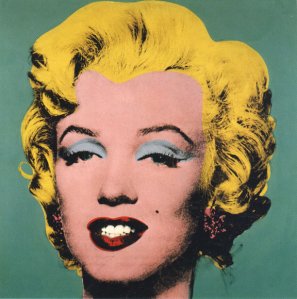
As well as a can of the Campbell’s Soup, Marilyn was iconic, soaked her admirer’s with a warm, good feeling and then was recklessly emptied and thrown away. In the great stretch of time, suppose Warhol was accurate, the paintings are of nothing, the soup means nothing and maybe Marilyn was treated by society in the very same way. So many people admire her now, even nowadays. Can a person’s life and accomplishments be consolidated to a acrylic painting that represents nothing?
Warhol’s paintings can absolutely make one think about what the priorities of human race are. The things that we put so much importance on are so fleeting and when they are made larger than life on a acrylic painting, they force us to account our mortality. plenty of Warhol’s artworks were in a way tied very closely to religion.
He created use of gold leaf in the tradition of iconic paintings of Byzantine Catholics. In Gold Marilyn Monroe depicts her iconic status, the affection of her admirers and the sheer lonesomeness of her life. Her face is painted as if she were in a newsprint advertising, another throw away in our lives. Warhol continually brought attention to the fame that affected objects and people to a religious following.
It is hard to make a bold intellectual connection by simply studying a Warhol’s acrylic painting. Only those that yet have a preconceived emotional bond to the subject of his paintings can feel anything from them. They do anyhow, directly invoke a memory, and those memories fire emotions. Looking at Marilyn Monroe in a Warhol acrylic painting can mean nothing to the observer if they have not heard of Marilyn Monroe and her tall story.
All contents © copyright 2010 ARTbyVENY.com
I invest substantial amount of time to find and research interesting and relevant topics for my blog page.
If you like to support my research efforts donate now to keep this blog site alive.

Thank you! Your donation is appreciated!
30 Dec 2010
by ARTbyVENY
in Uncategorized
Tags: all you can eat, Chinese buffet, earn, Fear destroys, Fear is forced, Fear is learned, Fear is toxic, feelings, gang member, gun, handcuffs, Kindergarten Cop, New York, poison, Respect, Respect builds, Respect is earned, Respect is nurturing, security officer, You don't need a gun to get it.
 Respect means a lot of different things. Respect can be shown through behavior and it can also be felt. We can act in ways which are considered respectful, yet we can also feel respect for someone and feel respected by someone. Because it is possible to act in ways that do not reflect how we really feel, the feeling of respect is more important than the behavior without the feeling. When the feeling is there, the behavior will naturally follow.
Respect means a lot of different things. Respect can be shown through behavior and it can also be felt. We can act in ways which are considered respectful, yet we can also feel respect for someone and feel respected by someone. Because it is possible to act in ways that do not reflect how we really feel, the feeling of respect is more important than the behavior without the feeling. When the feeling is there, the behavior will naturally follow.
As a new born has no concept of respect, and feels only its own needs, I believe that the only successful way to teach a child what respect is, is to earn the respect of the child as they slowly grow into a thinking human being. It is naive to believe that if someone says “Yes, Sir/ No, Sir,” it means they respect you.
As I see it, respect is something that is earned. You earn someone else’s respect easy by showing understanding of that person’s feelings, needs and thoughts into consideration. You must show your respect for someone else before it will come back to you. Respect cannot be demanded or forced, though sometimes people mistakenly believe that it can.
A New York City gang member was asked why he carried a gun. He replied: “Before I had this gun, I didn’t get no respect. Now I do.”

Or like the security officer, I saw the other day in an “all you can eat” Chinese buffet full of families with young kids: the guy was dressed in civil khakis, striped shirt and sneakers topped with heavy gun and handcuffs on his belt. He was looking odd with that big gun among the bunch of kids trying to get some food at the buffet and reminded me of the “Kindergarten Cop” movie.
Or like a friend of mine who bought a gun shortly after he acquired couple buildings with rental apartments and got few “professional renters” among the other residents. Every time he was going to visit his properties he would carry the gun and make the others well aware of it.
You don’t need a gun to get it.
There is a danger in mislabeling fear as respect. It is like if two jars in the medicine cabinet were mislabeled. What if poison ivy lotion were labeled as cough syrup, or chlorine as contact lens cleaner?
Fear is toxic
Respect is nurturing.
Fear destroys self-confidence. Respect builds it.
Fear is life-threatening. Respect is life-enhancing.
Fear is forced. Respect is earned.
Fear is learned. Respect is earned.
You don’t need a gun to get it!
All contents © copyright 2010 ARTbyVENY.com
I invest substantial amount of time to find and research interesting and relevant topics for my blog page.
If you like to support my research efforts donate now to keep this blog site alive.

Thank you! Your donation is appreciated!
Previous Older Entries Next Newer Entries




















